light MITSUBISHI OUTLANDER PHEV 2016 Owner's Manual (in English)
[x] Cancel search | Manufacturer: MITSUBISHI, Model Year: 2016, Model line: OUTLANDER PHEV, Model: MITSUBISHI OUTLANDER PHEV 2016Pages: 490, PDF Size: 22.02 MB
Page 6 of 490
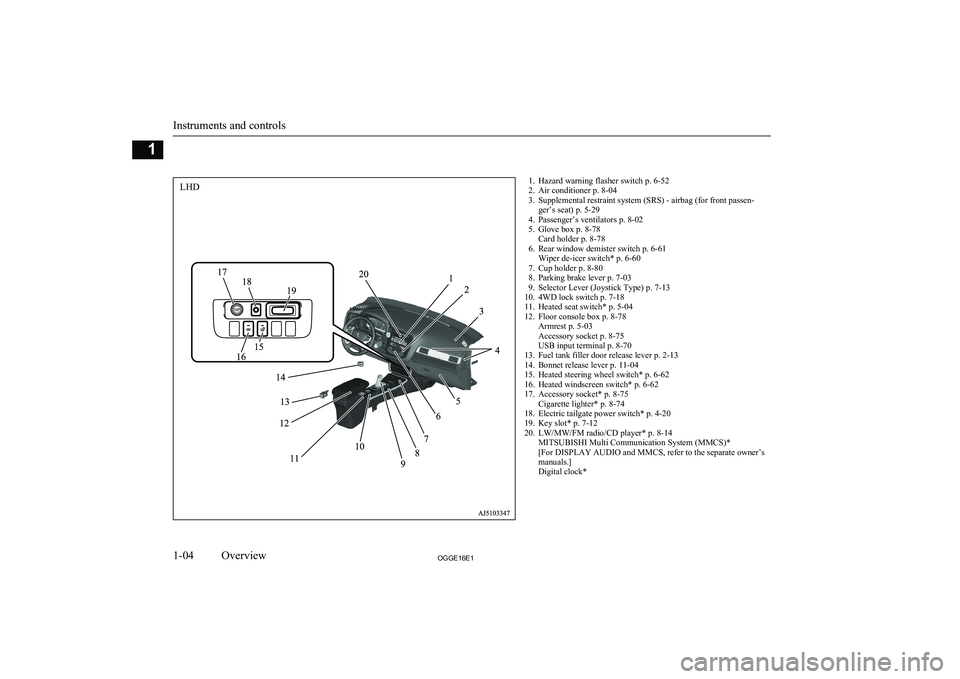
1. Hazard warning flasher switch p. 6-52
2. Air conditioner p. 8-04
3. Supplemental restraint system (SRS) - airbag (for front passen- ger’s seat) p. 5-29
4. Passenger’s ventilators p. 8-02
5. Glove box p. 8-78 Card holder p. 8-78
6. Rear window demister switch p. 6-61 Wiper de-icer switch* p. 6-60
7. Cup holder p. 8-80
8. Parking brake lever p. 7-03
9. Selector Lever (Joystick Type) p. 7-13
10. 4WD lock switch p. 7-18
11. Heated seat switch* p. 5-04
12. Floor console box p. 8-78 Armrest p. 5-03
Accessory socket p. 8-75
USB input terminal p. 8-70
13. Fuel tank filler door release lever p. 2-13
14. Bonnet release lever p. 11-04
15. Heated steering wheel switch* p. 6-62
16. Heated windscreen switch* p. 6-62
17. Accessory socket* p. 8-75 Cigarette lighter* p. 8-74
18. Electric tailgate power switch* p. 4-20
19. Key slot* p. 7-12
20. LW/MW/FM radio/CD player* p. 8-14 MITSUBISHI Multi Communication System (MMCS)*
[For DISPLAY AUDIO and MMCS, refer to the separate owner’s
manuals.]
Digital clock*
Instruments and controls
1-04OGGE16E1Overview1LHD
Page 8 of 490
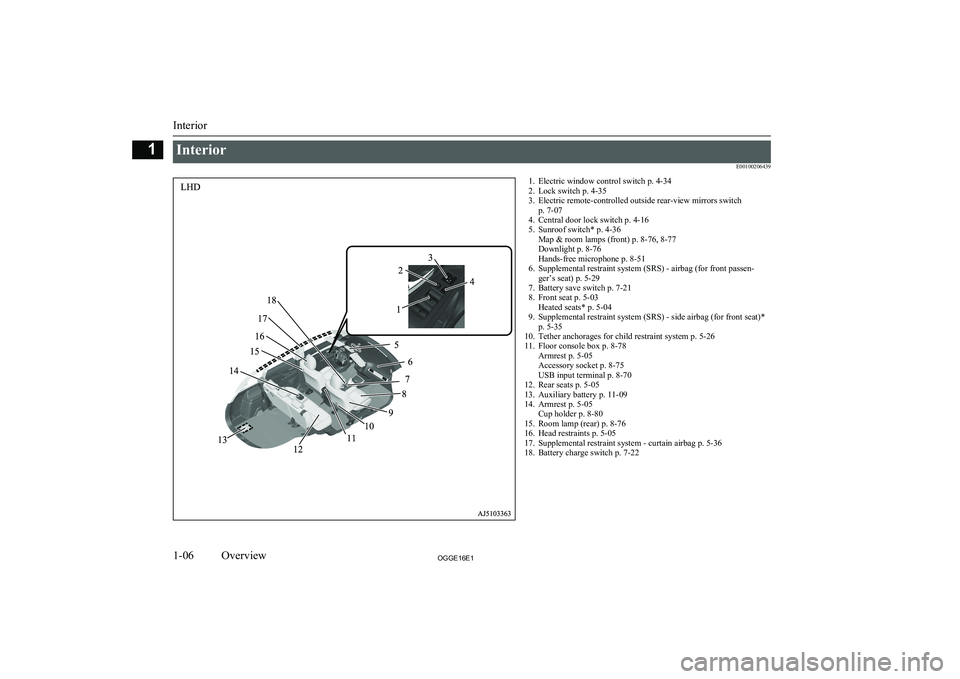
InteriorE001002064391. Electric window control switch p. 4-34
2. Lock switch p. 4-35
3. Electric remote-controlled outside rear-view mirrors switch p. 7-07
4. Central door lock switch p. 4-16
5. Sunroof switch* p. 4-36 Map & room lamps (front) p. 8-76, 8-77
Downlight p. 8-76
Hands-free microphone p. 8-51
6. Supplemental restraint system (SRS) - airbag (for front passen- ger’s seat) p. 5-29
7. Battery save switch p. 7-21
8. Front seat p. 5-03 Heated seats* p. 5-04
9. Supplemental restraint system (SRS) - side airbag (for front seat)* p. 5-35
10. Tether anchorages for child restraint system p. 5-26
11. Floor console box p. 8-78 Armrest p. 5-05
Accessory socket p. 8-75
USB input terminal p. 8-70
12. Rear seats p. 5-05
13. Auxiliary battery p. 11-09
14. Armrest p. 5-05 Cup holder p. 8-80
15. Room lamp (rear) p. 8-76
16. Head restraints p. 5-05
17. Supplemental restraint system - curtain airbag p. 5-36
18. Battery charge switch p. 7-22
Interior
1-06OGGE16E1Overview1
Page 9 of 490
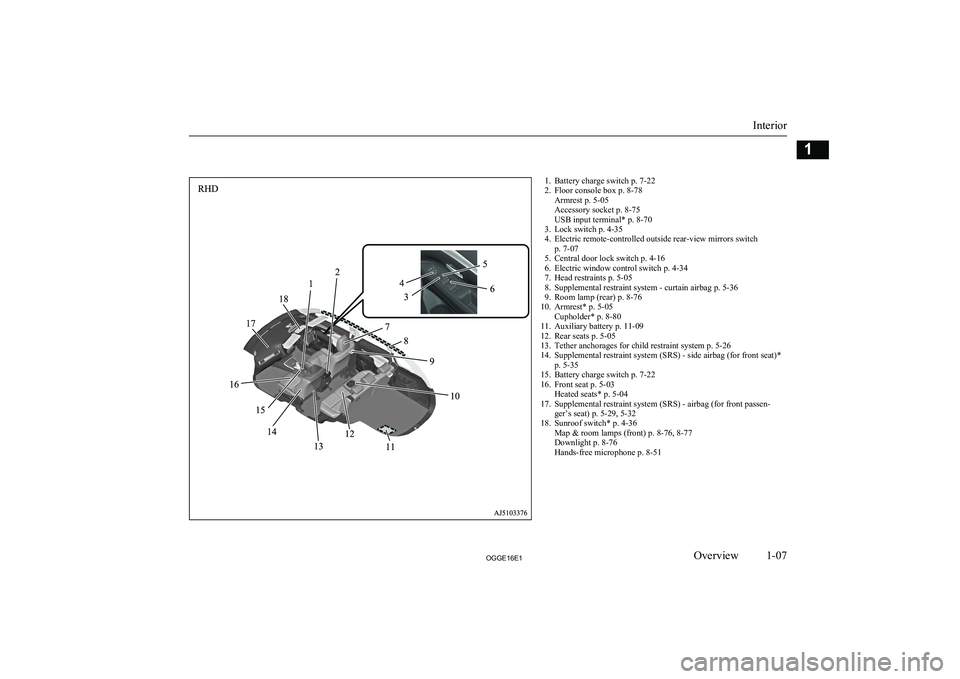
1. Battery charge switch p. 7-22
2. Floor console box p. 8-78 Armrest p. 5-05
Accessory socket p. 8-75
USB input terminal* p. 8-70
3. Lock switch p. 4-35
4. Electric remote-controlled outside rear-view mirrors switch p. 7-07
5. Central door lock switch p. 4-16
6. Electric window control switch p. 4-34
7. Head restraints p. 5-05
8. Supplemental restraint system - curtain airbag p. 5-36
9. Room lamp (rear) p. 8-76
10. Armrest* p. 5-05 Cupholder* p. 8-80
11. Auxiliary battery p. 11-09
12. Rear seats p. 5-05
13. Tether anchorages for child restraint system p. 5-26
14. Supplemental restraint system (SRS) - side airbag (for front seat)* p. 5-35
15. Battery charge switch p. 7-22
16. Front seat p. 5-03 Heated seats* p. 5-04
17. Supplemental restraint system (SRS) - airbag (for front passen- ger’s seat) p. 5-29, 5-32
18. Sunroof switch* p. 4-36 Map & room lamps (front) p. 8-76, 8-77
Downlight p. 8-76
Hands-free microphone p. 8-51
Interior
1-07OGGE16E1Overview1
Page 10 of 490
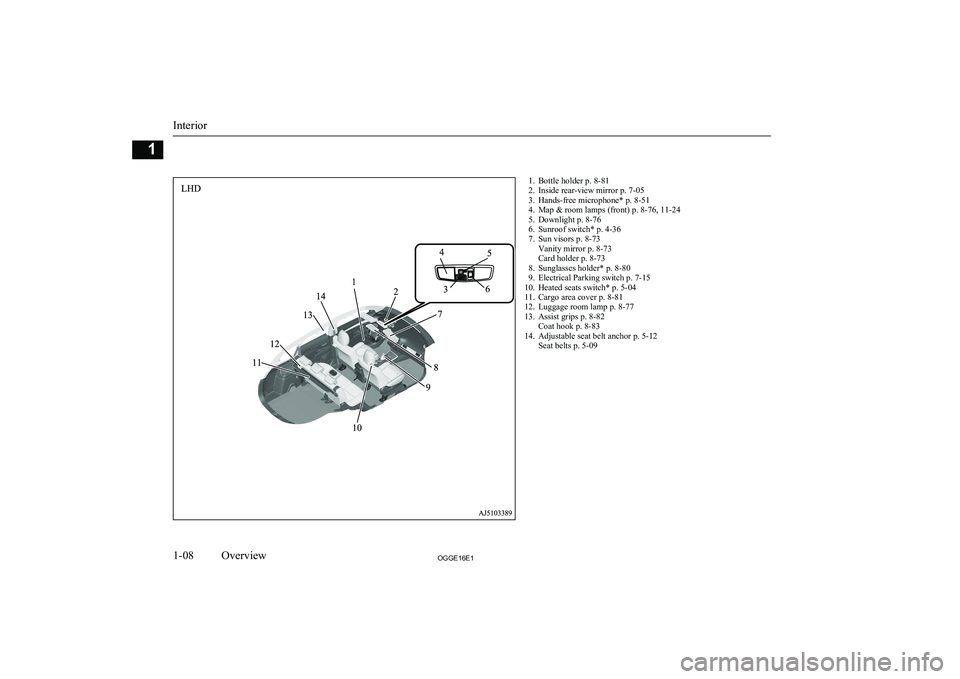
1. Bottle holder p. 8-81
2. Inside rear-view mirror p. 7-05
3. Hands-free microphone* p. 8-51
4. Map & room lamps (front) p. 8-76, 11-24
5. Downlight p. 8-76
6. Sunroof switch* p. 4-36
7. Sun visors p. 8-73 Vanity mirror p. 8-73
Card holder p. 8-73
8. Sunglasses holder* p. 8-80
9. Electrical Parking switch p. 7-15
10. Heated seats switch* p. 5-04
11. Cargo area cover p. 8-81
12. Luggage room lamp p. 8-77
13. Assist grips p. 8-82 Coat hook p. 8-83
14. Adjustable seat belt anchor p. 5-12 Seat belts p. 5-09
Interior
1-08OGGE16E1Overview1
Page 11 of 490
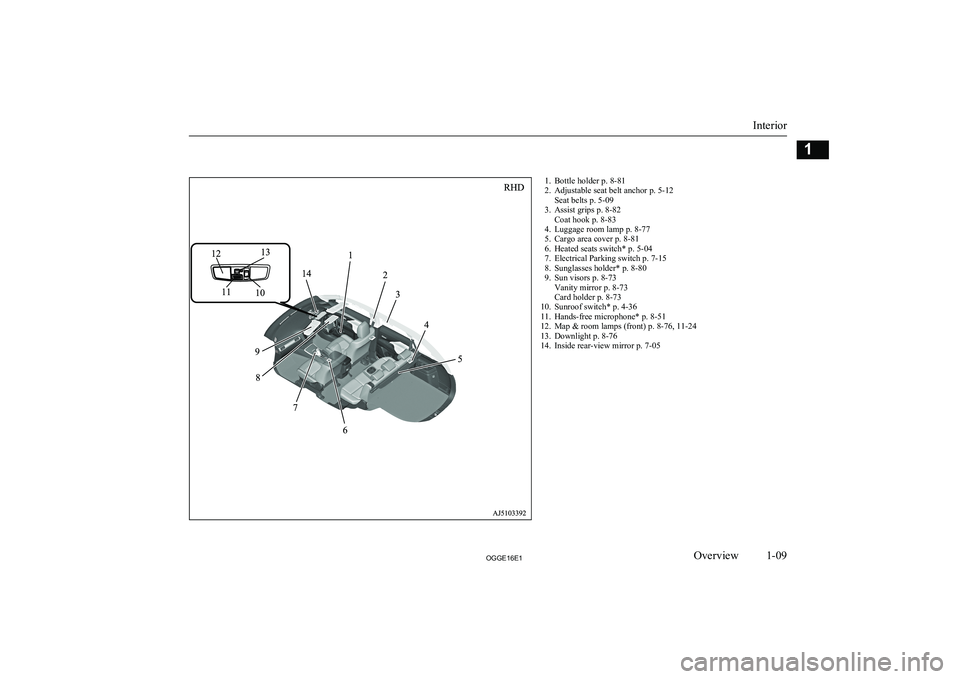
1. Bottle holder p. 8-81
2. Adjustable seat belt anchor p. 5-12 Seat belts p. 5-09
3. Assist grips p. 8-82 Coat hook p. 8-83
4. Luggage room lamp p. 8-77
5. Cargo area cover p. 8-81
6. Heated seats switch* p. 5-04
7. Electrical Parking switch p. 7-15
8. Sunglasses holder* p. 8-80
9. Sun visors p. 8-73 Vanity mirror p. 8-73
Card holder p. 8-73
10. Sunroof switch* p. 4-36
11. Hands-free microphone* p. 8-51
12. Map & room lamps (front) p. 8-76, 11-24
13. Downlight p. 8-76
14. Inside rear-view mirror p. 7-05
Interior
1-09OGGE16E1Overview1
Page 18 of 490
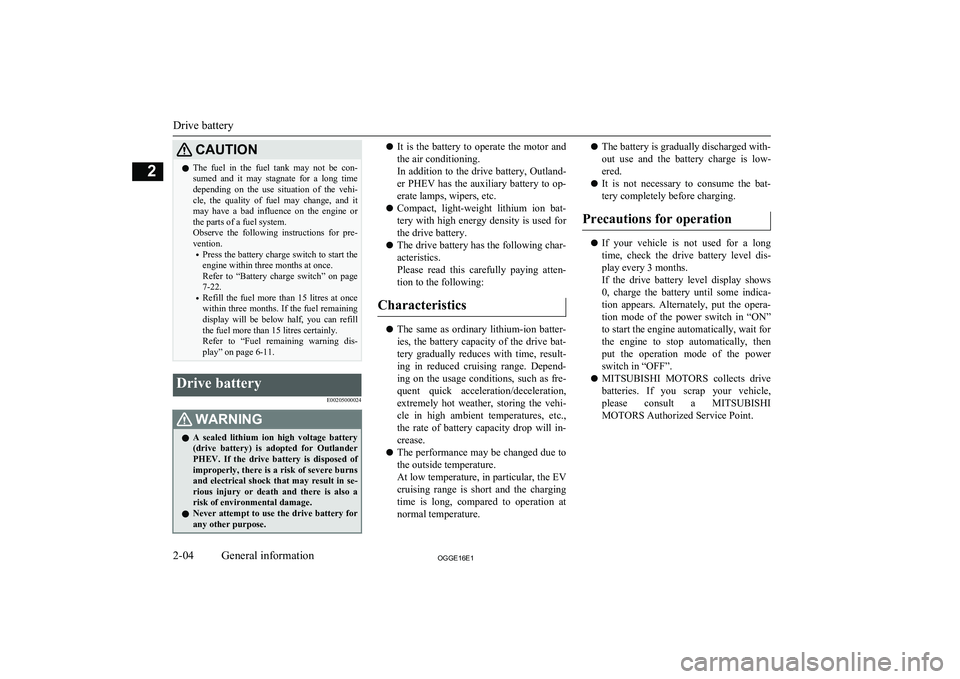
CAUTIONlThe fuel in the fuel tank may not be con-
sumed and it may stagnate for a long time
depending on the use situation of the vehi- cle, the quality of fuel may change, and it
may have a bad influence on the engine or the parts of a fuel system.
Observe the following instructions for pre-
vention.
• Press the battery charge switch to start the
engine within three months at once.Refer to “Battery charge switch” on page
7-22.
• Refill the fuel more than 15 litres at once
within three months. If the fuel remaining display will be below half, you can refillthe fuel more than 15 litres certainly.Refer to “Fuel remaining warning dis-
play” on page 6-11.Drive battery
E00205000024WARNINGlA sealed lithium ion high voltage battery
(drive battery) is adopted for OutlanderPHEV . If the drive battery is disposed of
improperly, there is a risk of severe burns
and electrical shock that may result in se-
rious injury or death and there is also a
risk of environmental damage.
l Never attempt to use the drive battery for
any other purpose.l It is the battery to operate the motor and
the air conditioning.
In addition to the drive battery, Outland-
er PHEV has the auxiliary battery to op-
erate lamps, wipers, etc.
l Compact, light-weight lithium ion bat-
tery with high energy density is used forthe drive battery.
l The drive battery has the following char-
acteristics.
Please read this carefully paying atten- tion to the following:
Characteristics
l The same as ordinary lithium-ion batter-
ies, the battery capacity of the drive bat-
tery gradually reduces with time, result- ing in reduced cruising range. Depend-
ing on the usage conditions, such as fre- quent quick acceleration/deceleration, extremely hot weather, storing the vehi-
cle in high ambient temperatures, etc.,
the rate of battery capacity drop will in- crease.
l The performance may be changed due to
the outside temperature.
At low temperature, in particular, the EV
cruising range is short and the charging time is long, compared to operation at
normal temperature.
l The battery is gradually discharged with-
out use and the battery charge is low- ered.
l It is not necessary to consume the bat-
tery completely before charging.
Precautions for operation
l If your vehicle is not used for a long
time, check the drive battery level dis-
play every 3 months.
If the drive battery level display shows
0, charge the battery until some indica- tion appears. Alternately, put the opera-
tion mode of the power switch in “ON” to start the engine automatically, wait for
the engine to stop automatically, then
put the operation mode of the power switch in “OFF”.
l MITSUBISHI
MOTORS collects drive
batteries. If you scrap your vehicle, please consult a MITSUBISHI
MOTORS Authorized Service Point.
Drive battery
2-04OGGE16E1General information2
Page 19 of 490
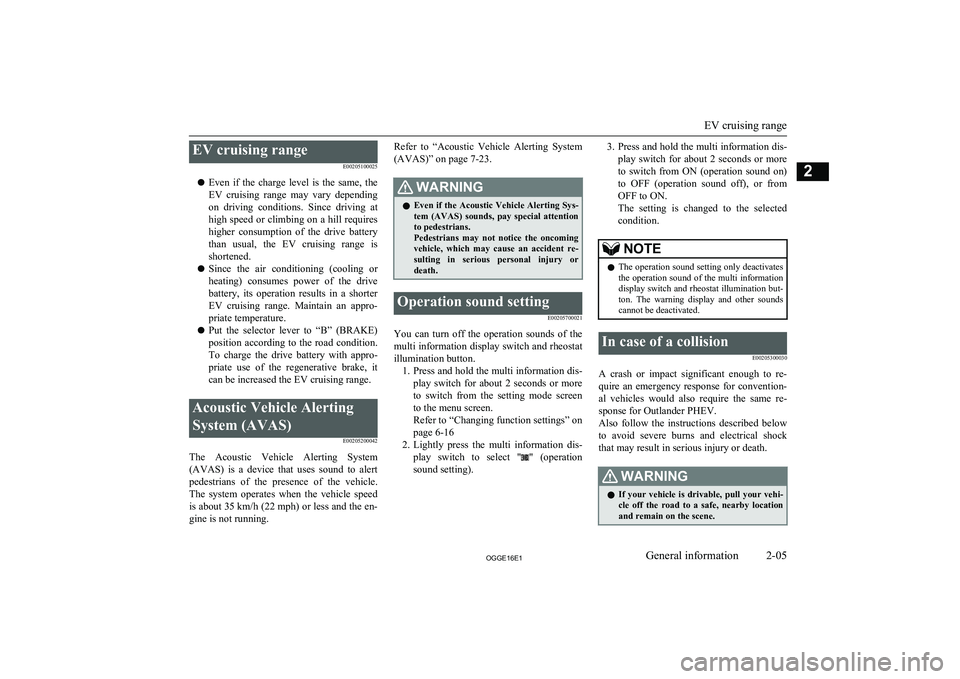
EV cruising rangeE00205100025
l Even if the charge level is the same, the
EV cruising range may vary depending on driving conditions. Since driving at
high speed or climbing on a hill requires higher consumption of the drive batterythan usual, the EV cruising range is shortened.
l Since the air conditioning (cooling or
heating) consumes power of the drive
battery, its operation results in a shorter EV cruising range. Maintain an appro- priate temperature.
l Put the selector lever to “B” (BRAKE)
position according to the road condition. To charge the drive battery with appro-priate use of the regenerative brake, it
can be increased the EV cruising range.Acoustic Vehicle Alerting
System (AVAS) E00205200042
The Acoustic Vehicle Alerting System(AVAS) is a device that uses sound to alert
pedestrians of the presence of the vehicle. The system operates when the vehicle speed
is about 35 km/h (22 mph) or less and the en-
gine is not running.
Refer to “Acoustic Vehicle Alerting System
(AVAS)” on page 7-23.WARNINGl Even if the Acoustic Vehicle Alerting Sys-
tem (AVAS) sounds, pay special attention
to pedestrians.
Pedestrians may not notice the oncoming vehicle, which may cause an accident re-
sulting in serious personal injury or death.Operation sound setting
E00205700021
You can turn off the operation sounds of the
multi information display switch and rheostat illumination button. 1. Press and hold the multi information dis-
play switch for about 2 seconds or more to switch from the setting mode screen
to the menu screen.
Refer to “Changing function settings” on
page 6-16
2. Lightly press the multi information dis-
play switch to select "
" (operation
sound setting).
3. Press and hold the multi information dis-
play switch for about 2 seconds or moreto switch from ON (operation sound on)
to OFF (operation sound off), or from OFF to ON.
The setting is changed to the selected
condition.NOTEl The operation sound setting only deactivates
the operation sound of the multi information
display switch and rheostat illumination but- ton. The warning display and other soundscannot be deactivated.In case of a collision
E00205300030
A crash or impact significant enough to re-
quire an emergency response for convention- al vehicles would also require the same re-sponse for Outlander PHEV.
Also follow the instructions described below to avoid severe burns and electrical shock
that may result in serious injury or death.
WARNINGl If your vehicle is drivable, pull your vehi-
cle off the road to a safe, nearby location
and remain on the scene.
EV cruising range
2-05OGGE16E1General information2
Page 37 of 490
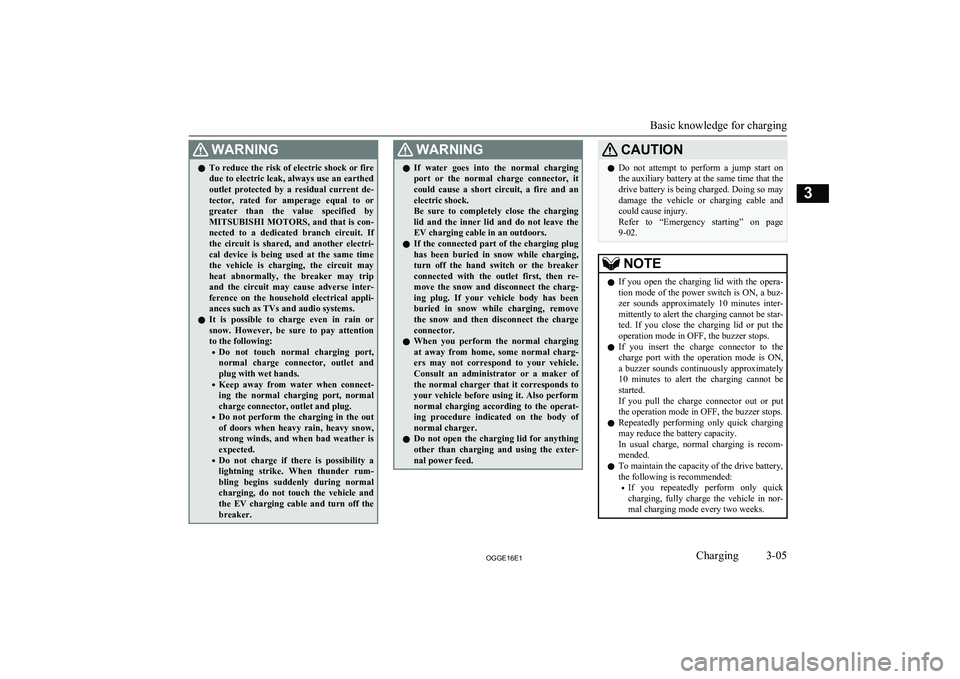
WARNINGlTo reduce the risk of electric shock or fire
due to electric leak, always use an earthed
outlet protected by a residual current de-
tector, rated for amperage equal to or greater than the value specified by MITSUBISHI MOTORS , and that is con-
nected to a dedicated branch circuit. If
the circuit is shared, and another electri- cal device is being used at the same time
the vehicle is charging, the circuit may heat abnormally, the breaker may trip
and the circuit may cause adverse inter-
ference on the household electrical appli- ances such as TVs and audio systems.
l It is possible to charge even in rain or
snow. However, be sure to pay attention
to the following:
• Do not touch normal charging port,
normal charge connector, outlet and plug with wet hands.
• Keep away from water when connect-
ing the normal charging port, normal
charge connector, outlet and plug.
• Do not perform the charging in the out
of doors when heavy rain, heavy snow, strong winds, and when bad weather is
expected.
• Do not charge if there is possibility a
lightning strike. When thunder rum- bling begins suddenly during normal
charging, do not touch the vehicle and the EV charging cable and turn off the
breaker.WARNINGl If water goes into the normal charging
port or the normal charge connector, itcould cause a short circuit, a fire and an electric shock.
Be sure to completely close the charging lid and the inner lid and do not leave the
EV charging cable in an outdoors.
l If the connected part of the charging plug
has been buried in snow while charging,
turn off the hand switch or the breaker
connected with the outlet first, then re- move the snow and disconnect the charg-
ing plug. If your vehicle body has been buried in snow while charging, remove
the snow and then disconnect the charge connector.
l When you perform the normal charging
at away from home, some normal charg-ers may not correspond to your vehicle.
Consult an administrator or a maker of
the normal charger that it corresponds to your vehicle before using it. Also perform
normal charging according to the operat-
ing procedure indicated on the body of normal charger.
l Do not open the charging lid for anything
other than charging and using the exter-
nal power feed.CAUTIONl Do not attempt to perform a jump start on
the auxiliary battery at the same time that the
drive battery is being charged. Doing so may
damage the vehicle or charging cable and
could cause injury.
Refer to “Emergency starting” on page 9-02.NOTEl If you open the charging lid with the opera-
tion mode of the power switch is ON, a buz- zer sounds approximately 10 minutes inter-mittently to alert the charging cannot be star- ted. If you close the charging lid or put theoperation mode in OFF, the buzzer stops.
l If you insert the charge connector to the
charge port with the operation mode is ON,
a buzzer sounds continuously approximately
10 minutes to alert the charging cannot be started.
If you pull the charge connector out or put the operation mode in OFF, the buzzer stops.
l Repeatedly performing only quick charging
may reduce the battery capacity.
In usual charge, normal charging is recom-
mended.
l To maintain the capacity of the drive battery,
the following is recommended:
• If you repeatedly perform only quick
charging, fully charge the vehicle in nor-
mal charging mode every two weeks.
Basic knowledge for charging
3-05OGGE16E1Charging3
Page 42 of 490
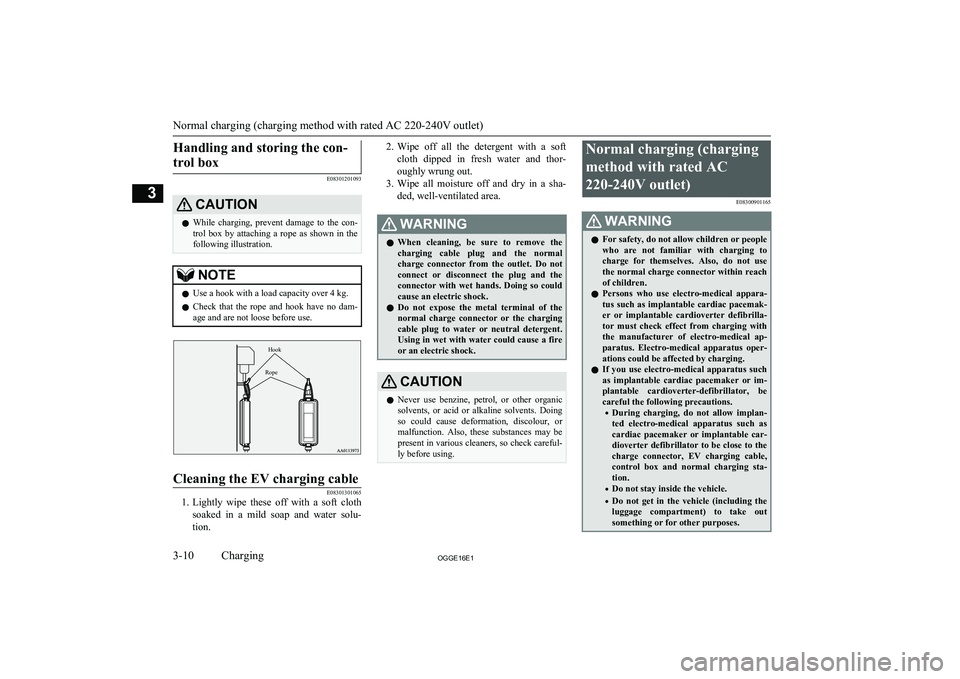
Handling and storing the con-trol box
E08301201093
CAUTIONl While charging, prevent damage to the con-
trol box by attaching a rope as shown in the
following illustration.NOTEl Use a hook with a load capacity over 4 kg.
l Check that the rope and hook have no dam-
age and are not loose before use.HookRope
Cleaning the EV charging cable
E08301301065
1. Lightly wipe these off with a soft cloth
soaked in a mild soap and water solu- tion.
2. Wipe off all the detergent with a soft
cloth dipped in fresh water and thor- oughly wrung out.
3. Wipe all moisture off and dry in a sha-
ded, well-ventilated area.WARNINGl When cleaning, be sure to remove the
charging cable plug and the normalcharge connector from the outlet. Do not
connect or disconnect the plug and the
connector with wet hands. Doing so could cause an electric shock.
l Do not expose the metal terminal of the
normal charge connector or the chargingcable plug to water or neutral detergent.
Using in wet with water could cause a fire or an electric shock.CAUTIONl Never use benzine, petrol, or other organic
solvents, or acid or alkaline solvents. Doing so could cause deformation, discolour, or
malfunction. Also, these substances may be
present in various cleaners, so check careful- ly before using.Normal charging (charging
method with rated AC220-240V outlet) E08300901165WARNINGlFor safety, do not allow children or people
who are not familiar with charging to
charge for themselves. Also, do not use
the normal charge connector within reach of children.
l Persons who use electro-medical appara-
tus such as implantable cardiac pacemak-
er or implantable cardioverter defibrilla- tor must check effect from charging with
the manufacturer of electro-medical ap- paratus. Electro-medical apparatus oper- ations could be affected by charging.
l If you use electro-medical apparatus such
as implantable cardiac pacemaker or im- plantable cardioverter-defibrillator, be
careful the following precautions.
• During charging, do not allow implan-
ted electro-medical apparatus such as
cardiac pacemaker or implantable car- dioverter defibrillator to be close to the
charge connector, EV charging cable,
control box and normal charging sta-
tion.
• Do not stay inside the vehicle.
• Do not get in the vehicle (including the
luggage compartment) to take outsomething or for other purposes.
Normal charging (charging method with rated AC 220-240V outlet)
3-10OGGE16E1Charging3
Page 60 of 490
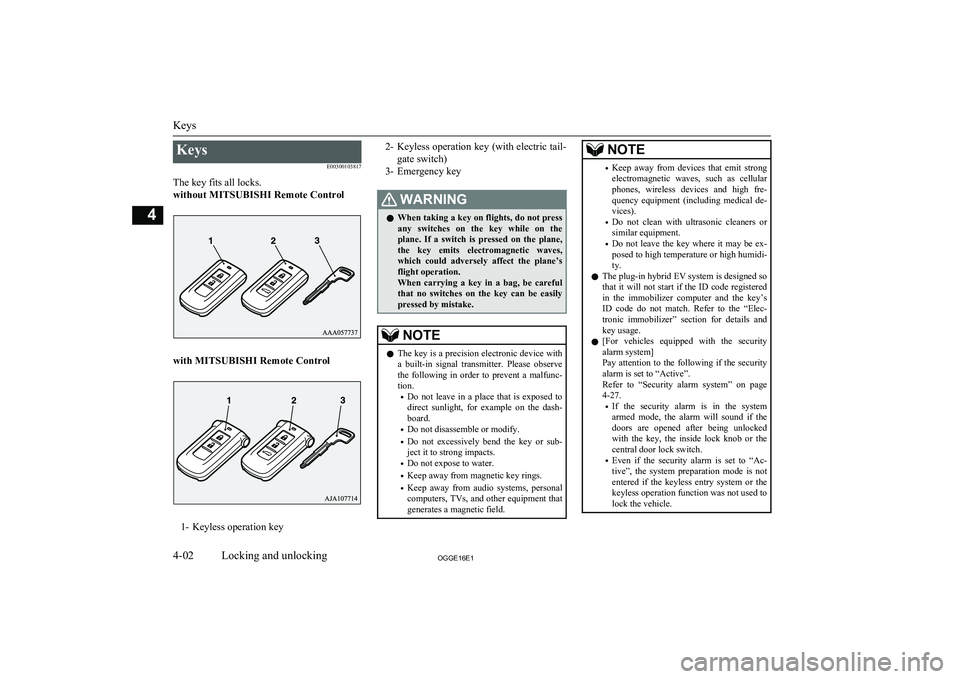
KeysE00300103817
The key fits all locks.
without MITSUBISHI Remote Control
with MITSUBISHI Remote Control
1- Keyless operation key
2- Keyless operation key (with electric tail-
gate switch)
3- Emergency keyWARNINGl When taking a key on flights, do not press
any switches on the key while on the plane. If a switch is pressed on the plane,
the key emits electromagnetic waves, which could adversely affect the plane’s flight operation.
When carrying a key in a bag, be careful that no switches on the key can be easily
pressed by mistake.NOTEl The key is a precision electronic device with
a built-in signal transmitter. Please observe
the following in order to prevent a malfunc- tion.
• Do not leave in a place that is exposed to
direct sunlight, for example on the dash- board.
• Do not disassemble or modify.
• Do not excessively bend the key or sub-
ject it to strong impacts.
• Do not expose to water.
• Keep away from magnetic key rings.
• Keep away from audio systems, personal
computers, TVs, and other equipment that generates a magnetic field.NOTE• Keep away from devices that emit strong
electromagnetic waves, such as cellular
phones, wireless devices and high fre- quency equipment (including medical de-
vices).
• Do not clean with ultrasonic cleaners or
similar equipment.
• Do not leave the key where it may be ex-
posed to high temperature or high humidi- ty.
l The plug-in hybrid EV system is designed so
that it will not start if the ID code registered
in the immobilizer computer and the key’s ID code do not match. Refer to the “Elec-
tronic immobilizer” section for details and key usage.
l [For vehicles equipped with the security
alarm system]
Pay attention to the following if the security
alarm is set to “Active”.
Refer to “Security alarm system” on page 4-27.
• If the security alarm is in the system
armed mode, the alarm will sound if the
doors are opened after being unlocked with the key, the inside lock knob or the
central door lock switch.
• Even if the security alarm is set to “Ac-
tive”, the system preparation mode is not entered if the keyless entry system or thekeyless operation function was not used to
lock the vehicle.
Keys
4-02OGGE16E1Locking and unlocking4